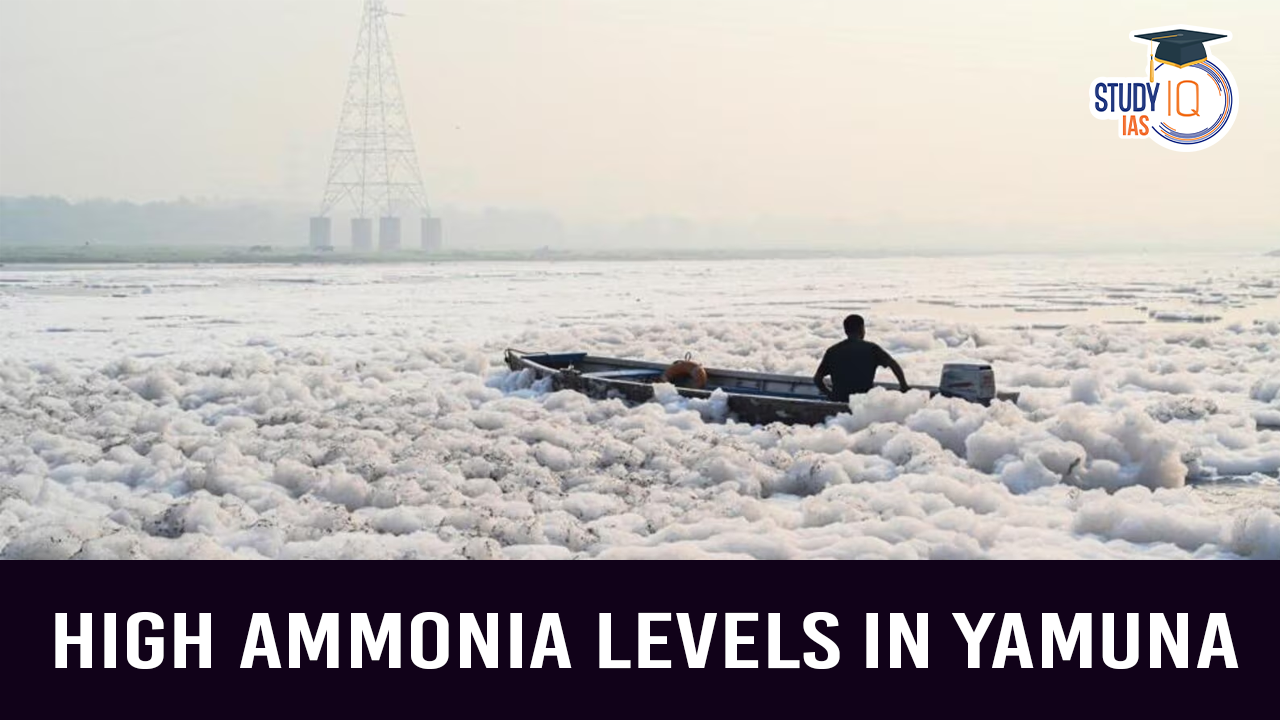Table of Contents
Context: The ongoing Yamuna water crisis has escalated into a political dispute between the Delhi & Haryana governments.
What is Ammonia?
- Ammonia (NH₃) is a colourless, water-soluble gas with a pungent smell.
- It is naturally present in the environment but can reach toxic levels due to human activities.
Major sources of ammonia pollution
- Runoff from agricultural lands (fertilizers and animal waste).
- Industrial discharge (dye units, distilleries, chemical plants).
- Untreated sewage from human settlements.
- Natural decomposition of organic matter like blue-green algae.
Health Impact of Ammonia
- Highly corrosive and can damage internal organs with prolonged exposure.
- Affects water quality, making it unsafe for human consumption.
- Long-term exposure can cause respiratory and digestive issues.
Why is Ammonia Pollution in the Yamuna a Concern for Delhi?
Sources of Ammonia in Yamuna (Haryana Region)
- Industrial discharge from dye units and distilleries in Panipat and Sonipat districts.
- Untreated sewage from residential colonies.
- Low water flow in winter worsens pollution as freshwater is scarce.
Impact on Delhi’s Water Supply
- Ammonia reduces the dissolved oxygen (DO) levels in water, making it unsuitable for consumption.
- Water Treatment Plants (WTPs) in Delhi cannot process water with ammonia levels above 1 ppm.
- When ammonia levels spike, Delhi faces water shortages due to treatment inefficiencies.
- The situation worsens in winter, as ammonia levels increase significantly due to reduced river flow.
Methods for Treating Ammonia-Laden Water
Chlorination (Chemical Treatment)
- How it works: Ammonia is neutralized using chlorine gas (Cl₂) or sodium hypochlorite (NaOCl).
- Limitation: Excess chlorine can lead to harmful disinfection byproducts (DBPs).
Biological Nitrification & Denitrification
- How it works: Bacteria convert ammonia into nitrites (NO₂⁻) and then nitrates (NO₃⁻), which are removed through further biological processes.
- Bacteria involved:
- Nitrosomonas bacteria convert ammonia to nitrite.
- Nitrobacter bacteria convert nitrite to nitrate.
- Limitation: Requires specific bacterial cultures and controlled conditions.
Reverse Osmosis (RO) & Ion Exchange (Membrane-Based Treatment)
- How it works: RO membranes filter ammonia molecules, removing them from water. This method is used in Singapore’s NEWater project for wastewater recycling.
- Limitation: Expensive and requires high energy input.
Constructing Wetlands (Nature-Based Solution)
- How it works: Wetland plants absorb ammonia from water. Microbial activity in root zones promotes natural nitrification.
- Limitation: Requires large areas and long-term monitoring.
Ammonia Stripping (Physical Process)
- How it works: Water is aerated at high pH (~10.5-11) to convert ammonium ions (NH₄⁺) into gaseous ammonia (NH₃), which escapes into the air.
- Limitation: Requires pH adjustment and high energy consumption.


 Mahuadanr Wolf Sanctuary: India’s Firs...
Mahuadanr Wolf Sanctuary: India’s Firs...
 Similipal Tiger Reserve (STR) Notified a...
Similipal Tiger Reserve (STR) Notified a...
 Antibiotic Pollution in Rivers, Reasons ...
Antibiotic Pollution in Rivers, Reasons ...





















